Based near Cullohill, Co Laois, Danny Delaney runs a tillage farm alongside a small agricultural contracting business, baling between 9,000 and 10,000 bales annually, 40% of which is straw.
Last year, Danny upgraded his Lely 245 baler and McHale 991 wrapper for a new Massey Ferguson 3130F round baler and Tanco 1400-V Series high speed wrapper and went down the route of an inline system.
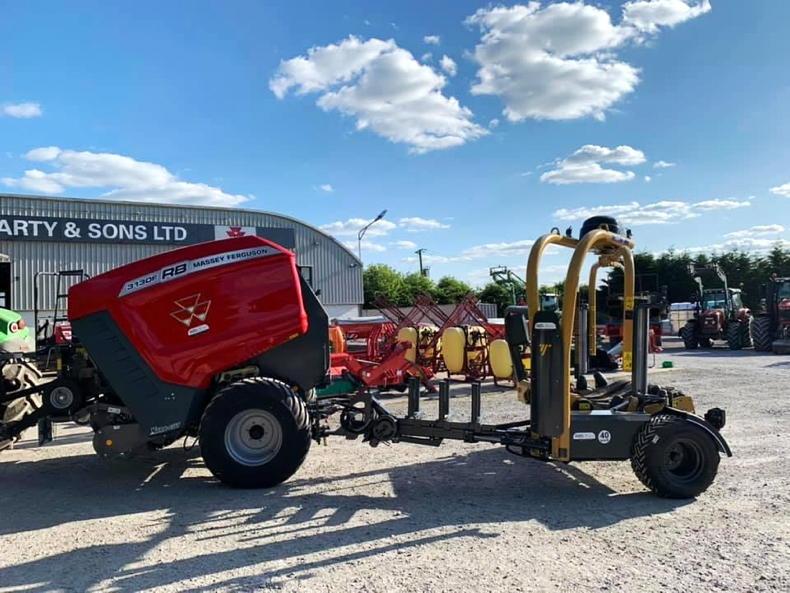
Danny's Massey Ferguson 3130F baler and Tanco 1400-V wrapper.
An inline baler wrapper combination is where a satellite wrapper unit is attached to a standard baler and worked in tandem by one operator on one tractor.
An inline setup works like a combination baler wrapper with the added versatility of being able to easily detach either machine and use it individually.
Such setups would have been more popular before the growth of combination balers. That said, a cohort of farmers and contractors across the country still operate such setups for one reason or another.
Danny explained that when weighing up his options whether to go down the inline route or not, there were more advantages of doing so than not.
The major benefit was that he can drop the wrapper when baling straw. With straw making up a considerable number of the bales made annually, it made sense not to opt for a combi unit.
This and two other main factors were key in Danny’s decision-making. Firstly, an inline system provided more flexibility over a combi.
Lower future costs
Not only could he choose any brand of baler or wrapper, the option is there to change the baler and not the wrapper or vice versa in years to come, leaving the cost of changing lower, he noted.
Danny also said that the buying price of the Massey Ferguson 3130F and Tanco 1400-V Series worked out cheaper than most combi balers.
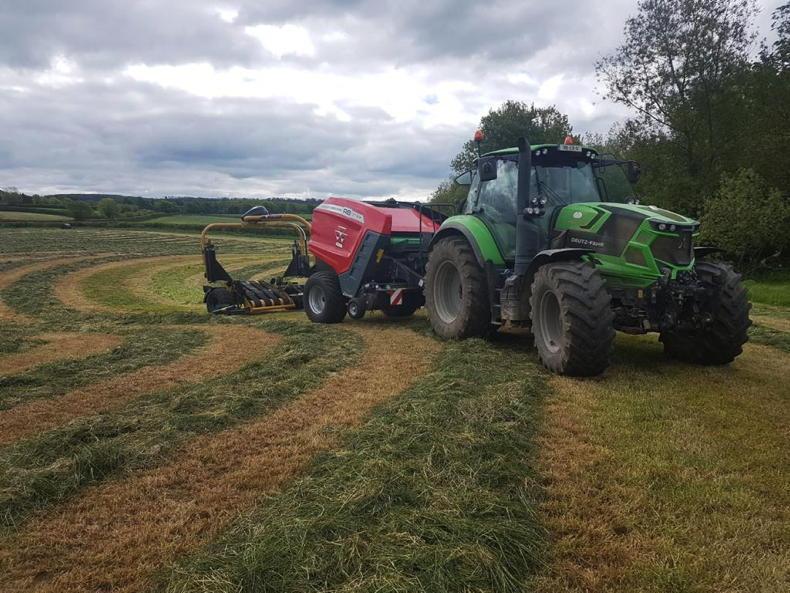
Danny said that the ‘inline’ baler and wrapper worked out cheaper than an integrated combi baler.
Finally, in tricky or challenging fields or wet conditions, the wrapper can be easily dropped and operated on a tractor of its own.
Danny noted that having his son about means there is someone about to work the wrapper separately if needed during the summer.
Danny explained that the drawbar connecting the wrapper to the baler was made by Rossmore Engineering and bolts directly on to the axle of the baler.
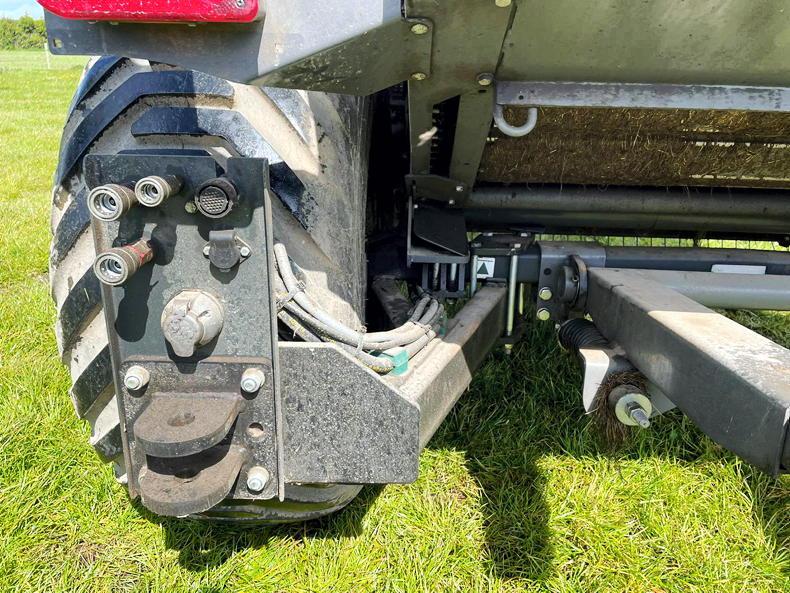
Rossmore Engineering manufactured the drawbar for the wrapper which bolts directly to the baler's axle.
He estimates the cost of leaving both machines so that they could work inline was in the region of €2,500. All in all, he believes it still worked out cheaper than buying a new combi.
MF 3130F Xtracut
Up front Danny runs a Massey Ferguson 3130F Xtracut as his baler of choice. The 3130F is fitted with a 2.25m, five-tine-bar camless pickup, which Massey Ferguson call its high-speed pickup.
He complimented the pickup’s ability to lift grass regardless if it is short or long. Between the pickup and rotor, there are two feed augers 25cm in diameter which feed grass into the rotor.
Behind the rotor is the Xtracut knife bank, which has a total of 17 knives.
Optionally, the 3130F Xtracut can be purchased with a 13- or 25-knife chopping unit.
Danny can choose from four knife combinations from the cab, which are 0, 8, 9 or the full 17. There are two hydraulically operated banks, one of eight and one of nine.
The two-stage Hydroflexcontrol protection system protects knives from foreign objects. Stage one is automatic mechanical floor cushioning, which helps clear minor blockages.
If that’s not enough and in the event of major blockage, the operator can activate stage two, which is the lowering of the floor and knife bank simultaneously, which will allow the blockage to pass.
There are 18 Powergrip rollers inside the chamber. The 10 rib rollers are made from seamless solid tube, according to the manufacturer.

Having liked his previous Lely 245 Danny decided to replace it with its successor, the 3130F Massey Ferguson baler.
The netting system remains similar to that found on the older generation Lely machines, which works well, according to Danny, although film binding isn’t an option.
Overall, Danny sees the 3130F as a straightforward reliable baler. The control terminal is the only area that could be improved, he stated.
“The control box on the older Lely and Welger machines were more straightforward, they would have been better off not changing it I think,” he said.
Tanco 1400-V Series
Danny’s wrapper of choice was the Tanco 1400-V Series satellite wrapper. The wrapper was one of the main reasons for changing to an inline system, he said.

Needing a faster way of wrapping Danny upgraded his single dispenser wrapper for the latest Tanco 1400-V Series.
“I wanted a faster wrapper. A lot of customers, including myself, have moved to 24 layers of wrap for better preservation. It was taking too long to wrap bales with 24 layers using the single dispenser wrapper.”
Danny opted for load-sensing hydraulics so that the tractor’s hydraulics are only used as required when the wrapper is in operation. This leaves the baler with full flow the rest of the time.
A key feature of the 1400-V, he said, is that it uses variable speed control hydraulics to variably control functions such as satellite speed.
The split table leaves bales delicately handled during loading and unloading, while keeping the centre of gravity as low as possible.
The cut-and-tie system is a simple and very effective design raising straight up and down, as opposed to a scissor-like motion, Danny noted.
The control unit and its automatic function is another standout feature for Danny, which leaves the process very simple, especially when working inline with the baler.
The only part of the process Danny does is drop the bale manually – this way he can leave it where and when he wants to.
Build quality of the 1400-V is another standout feature and something he feels is important in a wrapper given the weight of wet silage bales and the fact it is pulled in an offset position.
Prices: Massey Ferguson 3130F Xtracut list price: €50,000 plus VAT.
Tanco 1400-V list price: €26,390 plus VAT.
“Both machines work very well together. The setup suits me well. I wouldn’t write off a combi baler in the future and would strongly consider one if I wasn’t baling as much straw.”
“The major advantage is that in certain situations I can drop the wrapper and pull it separately. By doing this, I’ve also shed 1,320kg, plus the weight of a bale.
“With an experienced operator, in certain fields it’s every bit as fast as a combi baler. You just have to ensure the baler and wrapper are straight when releasing a bale from the chamber, otherwise the wrapper may not pick the bale up properly first attempt.
“The whole wrapping sequence is automatic, which leaves very little extra work, apart from keeping an eye on everything. About 50% of the grass baled is done inline and the rest baled and wrapped individually.
“Both machines have performed well with no faults.
“It’s a setup that has its place, let that be down to budget or whether a lot of straw is baled with the same baler or if ground conditions are better suited to a conventional baler and wrapper.”
Advantages
Ability to drop the wrapper and work separately.Lower price over a combi baler.Disadvantages
Not as manoeuvrable as a combi baler.Baler and wrapper need to be straight during bale transfer.
Based near Cullohill, Co Laois, Danny Delaney runs a tillage farm alongside a small agricultural contracting business, baling between 9,000 and 10,000 bales annually, 40% of which is straw.
Last year, Danny upgraded his Lely 245 baler and McHale 991 wrapper for a new Massey Ferguson 3130F round baler and Tanco 1400-V Series high speed wrapper and went down the route of an inline system.

Danny's Massey Ferguson 3130F baler and Tanco 1400-V wrapper.
An inline baler wrapper combination is where a satellite wrapper unit is attached to a standard baler and worked in tandem by one operator on one tractor.
An inline setup works like a combination baler wrapper with the added versatility of being able to easily detach either machine and use it individually.
Such setups would have been more popular before the growth of combination balers. That said, a cohort of farmers and contractors across the country still operate such setups for one reason or another.
Danny explained that when weighing up his options whether to go down the inline route or not, there were more advantages of doing so than not.
The major benefit was that he can drop the wrapper when baling straw. With straw making up a considerable number of the bales made annually, it made sense not to opt for a combi unit.
This and two other main factors were key in Danny’s decision-making. Firstly, an inline system provided more flexibility over a combi.
Lower future costs
Not only could he choose any brand of baler or wrapper, the option is there to change the baler and not the wrapper or vice versa in years to come, leaving the cost of changing lower, he noted.
Danny also said that the buying price of the Massey Ferguson 3130F and Tanco 1400-V Series worked out cheaper than most combi balers.

Danny said that the ‘inline’ baler and wrapper worked out cheaper than an integrated combi baler.
Finally, in tricky or challenging fields or wet conditions, the wrapper can be easily dropped and operated on a tractor of its own.
Danny noted that having his son about means there is someone about to work the wrapper separately if needed during the summer.
Danny explained that the drawbar connecting the wrapper to the baler was made by Rossmore Engineering and bolts directly on to the axle of the baler.

Rossmore Engineering manufactured the drawbar for the wrapper which bolts directly to the baler's axle.
He estimates the cost of leaving both machines so that they could work inline was in the region of €2,500. All in all, he believes it still worked out cheaper than buying a new combi.
MF 3130F Xtracut
Up front Danny runs a Massey Ferguson 3130F Xtracut as his baler of choice. The 3130F is fitted with a 2.25m, five-tine-bar camless pickup, which Massey Ferguson call its high-speed pickup.
He complimented the pickup’s ability to lift grass regardless if it is short or long. Between the pickup and rotor, there are two feed augers 25cm in diameter which feed grass into the rotor.
Behind the rotor is the Xtracut knife bank, which has a total of 17 knives.
Optionally, the 3130F Xtracut can be purchased with a 13- or 25-knife chopping unit.
Danny can choose from four knife combinations from the cab, which are 0, 8, 9 or the full 17. There are two hydraulically operated banks, one of eight and one of nine.
The two-stage Hydroflexcontrol protection system protects knives from foreign objects. Stage one is automatic mechanical floor cushioning, which helps clear minor blockages.
If that’s not enough and in the event of major blockage, the operator can activate stage two, which is the lowering of the floor and knife bank simultaneously, which will allow the blockage to pass.
There are 18 Powergrip rollers inside the chamber. The 10 rib rollers are made from seamless solid tube, according to the manufacturer.

Having liked his previous Lely 245 Danny decided to replace it with its successor, the 3130F Massey Ferguson baler.
The netting system remains similar to that found on the older generation Lely machines, which works well, according to Danny, although film binding isn’t an option.
Overall, Danny sees the 3130F as a straightforward reliable baler. The control terminal is the only area that could be improved, he stated.
“The control box on the older Lely and Welger machines were more straightforward, they would have been better off not changing it I think,” he said.
Tanco 1400-V Series
Danny’s wrapper of choice was the Tanco 1400-V Series satellite wrapper. The wrapper was one of the main reasons for changing to an inline system, he said.

Needing a faster way of wrapping Danny upgraded his single dispenser wrapper for the latest Tanco 1400-V Series.
“I wanted a faster wrapper. A lot of customers, including myself, have moved to 24 layers of wrap for better preservation. It was taking too long to wrap bales with 24 layers using the single dispenser wrapper.”
Danny opted for load-sensing hydraulics so that the tractor’s hydraulics are only used as required when the wrapper is in operation. This leaves the baler with full flow the rest of the time.
A key feature of the 1400-V, he said, is that it uses variable speed control hydraulics to variably control functions such as satellite speed.
The split table leaves bales delicately handled during loading and unloading, while keeping the centre of gravity as low as possible.
The cut-and-tie system is a simple and very effective design raising straight up and down, as opposed to a scissor-like motion, Danny noted.
The control unit and its automatic function is another standout feature for Danny, which leaves the process very simple, especially when working inline with the baler.
The only part of the process Danny does is drop the bale manually – this way he can leave it where and when he wants to.
Build quality of the 1400-V is another standout feature and something he feels is important in a wrapper given the weight of wet silage bales and the fact it is pulled in an offset position.
Prices: Massey Ferguson 3130F Xtracut list price: €50,000 plus VAT.
Tanco 1400-V list price: €26,390 plus VAT.
“Both machines work very well together. The setup suits me well. I wouldn’t write off a combi baler in the future and would strongly consider one if I wasn’t baling as much straw.”
“The major advantage is that in certain situations I can drop the wrapper and pull it separately. By doing this, I’ve also shed 1,320kg, plus the weight of a bale.
“With an experienced operator, in certain fields it’s every bit as fast as a combi baler. You just have to ensure the baler and wrapper are straight when releasing a bale from the chamber, otherwise the wrapper may not pick the bale up properly first attempt.
“The whole wrapping sequence is automatic, which leaves very little extra work, apart from keeping an eye on everything. About 50% of the grass baled is done inline and the rest baled and wrapped individually.
“Both machines have performed well with no faults.
“It’s a setup that has its place, let that be down to budget or whether a lot of straw is baled with the same baler or if ground conditions are better suited to a conventional baler and wrapper.”
Advantages
Ability to drop the wrapper and work separately.Lower price over a combi baler.Disadvantages
Not as manoeuvrable as a combi baler.Baler and wrapper need to be straight during bale transfer. 










 This is a subscriber-only article
This is a subscriber-only article





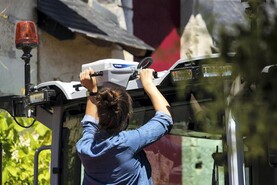
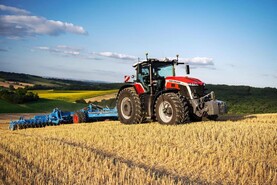


SHARING OPTIONS: